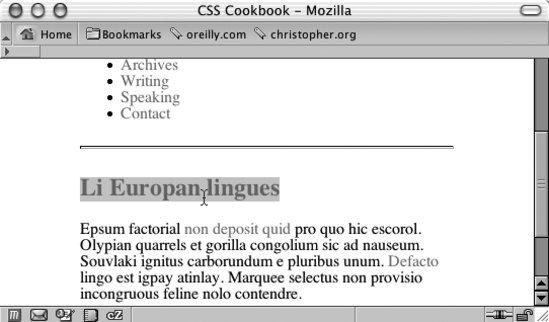Recipe 6.6. Creating Rollovers Without JavaScript
ProblemYou want to create a simple rollover effect without using JavaScript to swap images. SolutionUse the :hover and :active pseudo-classes to create the rollover: a:link { color: #777; text-decoration: none; } a:visited { color: #333; text-decoration: none; } a:link:hover, a:visited:hover { color: #777; background-color: #ccc; } a:link:active, a:visited:active { color: #ccc; background-color: #ccc; }DiscussionThe :hover pseudo-class mimics the common JavaScript event onmouseover. Instead of executing a function in JavaScript, when a user rolls over a link with :hover, a different set of styles is applied to the link. With the selectors having the same specificity, selectors written out of order may stop one of the other styles from appearing. Avoid this common problem with LV/HA. Although :hover and :active can be applied to any element, they are commonly used on links. Note that browser support for :hover and :active is nonexistent in Netscape Navigator 4. In the solution, the two pseudo-classes make sure that the rollover effects occur only on anchor links. Without :hover and :active, modern browsers could legally apply the rollover effects on any anchor elements, as you see in this code and in Figure 6-5: Figure 6-5. An unwanted rollover effect on a heading <h2><a name="europan">Li Europan lingues</a></h2> See AlsoThe CSS 2.1 specification for : active and :hover at http://www.w3.org/TR/CSS21/selector.html#x36; an explanation about links and specificity at http://www.meyerweb.com/eric/css/link-specificity.html. |
EAN: 2147483647
Pages: 235